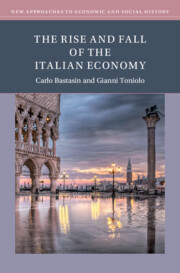Book contents
- The Rise and Fall of the Italian Economy
- New Approaches to Economic and Social History
- The Rise and Fall of the Italian Economy
- Copyright page
- Dedication
- Contents
- Figures
- Tables
- Preface
- 1 Italy’s Parabola, 1861–2022
- 2 Slow Economic Unification, 1861–1896
- 3 Convergence and Sorpasso
- 4 The Trauma of 1992
- 5 The Lost Opportunity, 1996–2007
- 6 Sliding toward Zero Growth
- 7 The Canary in the Coalmine
- Notes
- References
- Index
6 - Sliding toward Zero Growth
Published online by Cambridge University Press: 24 August 2023
- The Rise and Fall of the Italian Economy
- New Approaches to Economic and Social History
- The Rise and Fall of the Italian Economy
- Copyright page
- Dedication
- Contents
- Figures
- Tables
- Preface
- 1 Italy’s Parabola, 1861–2022
- 2 Slow Economic Unification, 1861–1896
- 3 Convergence and Sorpasso
- 4 The Trauma of 1992
- 5 The Lost Opportunity, 1996–2007
- 6 Sliding toward Zero Growth
- 7 The Canary in the Coalmine
- Notes
- References
- Index
Summary
The twin crises of 2008–9 and 2011–12 witnessed the largest GDP loss in Italian history, except the last two WWII years. In 2020, Italy’s GDP per person was still below the 2007 level. The economy was slow and uncertain in reacting to the crisis. The fiscal response proved to be inadequate, but it nevertheless resulted in a substantial increase in the debt/GDP ratio, which fed into uncertainty about the future of the country, affecting investments. The growth rate of the economy was low, spreading doubts about debt sustainability in the medium-long run. Zero growth accentuated the antagonistic mentality in politics. The traditional North–South gap widened, as did poverty, income inequality, and social divides. Distributional coalitions gained political leverage. The 2018 general elections yielded a populist majority.
- Type
- Chapter
- Information
- The Rise and Fall of the Italian Economy , pp. 127 - 143Publisher: Cambridge University PressPrint publication year: 2023

